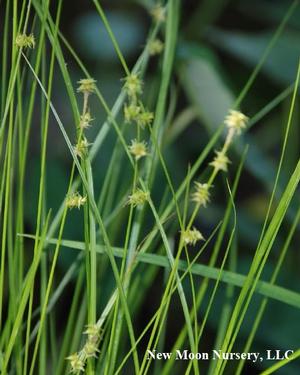Printed at http://www.newmoonnursery.com/index.cfm/
Carex blanda
Common Wood Sedge
Native to North America
FIRST IMPRESSIONS: Carex blanda is a rhizomatous perennial sedge that matures into compact mounded clumps. The shiny deep green foliage is evergreen and up to 8” long. In late spring interesting green flower spikes are displayed above the leaves. Plants occur in part sun to part shade in moist to mesic soils. This sedge has great landscape potential as a groundcover for woodlands or shade gardens.
HABITAT & HARDINESS: Carex blanda occurs in most of eastern and central North America west to Manitoba, North Dakota, Wyoming, Kansas, Oklahoma and Texas.
Plants are indigenous to moist bottomland woods, upland woods, creek and river banks, savannas, thickets, disturbed prairies and meadows, shaded lawns and gardens. This sedge occurs in deciduous and mixed deciduous/coniferous woods and in high quality or disturbed habitats. Carex blanda can also serve as a shade tolerant groundcover in tallgrass prairies.
Hardy from USDA Zones 3-9.
PLANT DESCRIPTION: Carex blanda forms dense tufts of glossy arching foliage from short rhizomes.
Leaves are lime green and about 8” long and a little more than 1/4” wide. The blades are evergreen and are furrowed lengthwise.
In late spring, sharply triangular culms with small wings rise above the foliage bearing 3 to 5 spikelets. The terminal spikelet is staminate (or “male”), about ½” long and silvery turning brown.
The pistillate spikelets below are cylindrical and about ¾” long. They are bursting with 10-30 pale green grape-like perigynia and their associated scales. Each perigynium is asymmetrical and tipped with a short curved beak.
The upper pistillate spikelet is almost sessile and those beneath have longer stalks. All have leaf-like bracts up to 8” long.
Clusters of three angled light brown achenes appear after flowering.
This sedge is an average of 2’ tall with an equal spread.
CULTURAL & MAINTENANCE NEEDS: Carex blanda prospers in partial sun or partial shade in moist or mesic soils. Plants tolerate clay loam, rocky soils, wet soils, alkaline pH, full sun and dry shade.
Established plants are somewhat drought tolerant and are pest resistant and unpalatable to deer and other herbivores.
In garden situations, plants can be cut to the ground during late winter before new growth is initiated.
In disturbed sites with bare soil, this sedge can spread aggressively.
LANDSCAPE USES: Carex blanda is a useful Groundcover for a Shade Garden and is especially effective when Grouped or Massed with spring wildflowers, low growing bulbs or ferns. The unique leaf texture allows this sedge to serve as an eye catching Accent. Plants provide Erosion Control and Winter Interest and are appropriate for Deer Resistant Plantings, Low Maintenance Plantings, Restoration Projects and Wildlife Gardens.
This sedge is an excellent native substitute for the popular Asian groundcovers Liriope muscari and Ophiopogon japonicus.
COMPANION & UNDERSTUDY PLANTS: Suitable garden companions for Carex blanda could include Anemone virginiana, Chrysogonum virginianum, Eupatorium colestinum, Heuchera americana 'Dales Strain', Polystichum acrostichoides, and Phlox divaricata.
The very adaptable Carex amphibola could stand in if a substitute is needed.
TRIVIA: Carex blanda differs from other Carex spp. due to its dense clumping habit, slightly winged culms, terminal staminate spikelets and lopsided beaked perigynia.
Sedges host Appalachian Brown and Eyed Brown caterpillars. Various birds and squirrels feed on the seeds.
Height:
2 ftSpread:
2 ftSpacing:
3 ftUSDA Hardiness Zone:
3-9Bloom Color:
GreenCarex blanda Characteristics
Attracts Wildlife
- Butterflies
- Songbirds
- Pollinators
Attributes
- East-Coast Native
- Clay Soil
- Bog
- Rain Garden
Exposure
- Full Shade to Full Sun
Flowering Months
- May
Foliage Color
- Green
Grass Season
- Cool Season Grass
Groundcover Foot-Traffic Tolerances
- Moderate
Growth Rate
- Fast
Lawn Replacement or Groundcover
- Groundcover
Season of Interest (Foliage)
- Summer
- Spring
- Winter
- Fall
Soil Moisture Preference
- Moist to Dry
Interesting Notes:
Sedges host Appalachian Brown and Eyed Brown caterpillars. Various birds and squirrels feed on the seeds.

